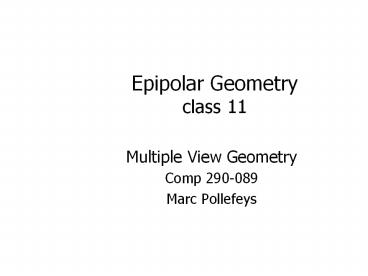Epipolar Geometry class 11 - PowerPoint PPT Presentation
Title:
Epipolar Geometry class 11
Description:
Epipolar Geometry class 11 Multiple View Geometry Comp 290-089 Marc Pollefeys Content Background: Projective geometry (2D, 3D), Parameter estimation, Algorithm ... – PowerPoint PPT presentation
Number of Views:230
Avg rating:3.0/5.0
Title: Epipolar Geometry class 11
1
Epipolar Geometryclass 11
- Multiple View Geometry
- Comp 290-089
- Marc Pollefeys
2
Content
- Background Projective geometry (2D, 3D),
Parameter estimation, Algorithm evaluation. - Single View Camera model, Calibration, Single
View Geometry. - Two Views Epipolar Geometry, 3D reconstruction,
Computing F, Computing structure, Plane and
homographies. - Three Views Trifocal Tensor, Computing T.
- More Views N-Linearities, Multiple view
reconstruction, Bundle adjustment,
auto-calibration, Dynamic SfM, Cheirality, Duality
3
Multiple View Geometry course schedule(subject
to change)
Jan. 7, 9 Intro motivation Projective 2D Geometry
Jan. 14, 16 (no class) Projective 2D Geometry
Jan. 21, 23 Projective 3D Geometry (no class)
Jan. 28, 30 Parameter Estimation Parameter Estimation
Feb. 4, 6 Algorithm Evaluation Camera Models
Feb. 11, 13 Camera Calibration Single View Geometry
Feb. 18, 20 Epipolar Geometry 3D reconstruction
Feb. 25, 27 Fund. Matrix Comp. Structure Comp.
Mar. 4, 6 Planes Homographies Trifocal Tensor
Mar. 18, 20 Three View Reconstruction Multiple View Geometry
Mar. 25, 27 MultipleView Reconstruction Bundle adjustment
Apr. 1, 3 Auto-Calibration Papers
Apr. 8, 10 Dynamic SfM Papers
Apr. 15, 17 Cheirality Papers
Apr. 22, 24 Duality Project Demos
4
More Single-View Geometry
- Projective cameras and
- planes, lines, conics and quadrics.
- Camera calibration and vanishing points,
calibrating conic and the IAC
5
Two-view geometry
Epipolar geometry 3D reconstruction F-matrix
comp. Structure comp.
6
Three questions
- Correspondence geometry Given an image point x
in the first view, how does this constrain the
position of the corresponding point x in the
second image?
- (ii) Camera geometry (motion) Given a set of
corresponding image points xi ?xi, i1,,n,
what are the cameras P and P for the two views?
- (iii) Scene geometry (structure) Given
corresponding image points xi ?xi and cameras
P, P, what is the position of (their pre-image)
X in space?
7
The epipolar geometry
(a)
C,C,x,x and X are coplanar
8
The epipolar geometry
b
What if only C,C,x are known?
9
The epipolar geometry
a
All points on p project on l and l
10
The epipolar geometry
b
Family of planes p and lines l and l
Intersection in e and e
11
The epipolar geometry
epipoles e,e intersection of baseline with
image plane projection of projection center in
other image vanishing point of camera motion
direction
an epipolar plane plane containing baseline
(1-D family)
an epipolar line intersection of epipolar plane
with image (always come in corresponding pairs)
12
Example converging cameras
13
Example motion parallel with image plane
14
(No Transcript)
15
The fundamental matrix F
algebraic representation of epipolar geometry
we will see that mapping is (singular)
correlation (i.e. projective mapping from points
to lines) represented by the fundamental matrix F
16
The fundamental matrix F
geometric derivation
mapping from 2-D to 1-D family (rank 2)
17
The fundamental matrix F
algebraic derivation
(note doesnt work for CC ? F0)
18
The fundamental matrix F
correspondence condition
The fundamental matrix satisfies the condition
that for any pair of corresponding points x?x in
the two images
19
The fundamental matrix F
F is the unique 3x3 rank 2 matrix that satisfies
xTFx0 for all x?x
- Transpose if F is fundamental matrix for (P,P),
then FT is fundamental matrix for (P,P) - Epipolar lines lFx lFTx
- Epipoles on all epipolar lines, thus eTFx0, ?x
?eTF0, similarly Fe0 - F has 7 d.o.f. , i.e. 3x3-1(homogeneous)-1(rank2)
- F is a correlation, projective mapping from a
point x to a line lFx (not a proper
correlation, i.e. not invertible)
20
Epipolar Line Homography
21
The epipolar line geometry
l,l epipolar lines, k line not through e ?
lFkxl and symmetrically lFTkxl
(pick ke, since eTe?0)
22
Pure Translation camera motion
23
Fundamental matrix for pure translation
Forward motion
24
Fundamental matrix for pure translation
motion starts at x and moves towards e, faster
depending on Z
pure translation F only 2 d.o.f., xTexx0 ?
auto-epipolar
25
General motion
26
Geometric representation of F
Fs Steiner conic, 5 d.o.f. Faxax pole of
line ee w.r.t. Fs, 2 d.o.f.
27
Pure planar motion
Steiner conic Fs is degenerate (two lines)
28
Projective transformation and invariance
Derivation based purely on projective concepts
F invariant to transformations of projective
3-space
unique
not unique
canonical form
29
Projective ambiguity of cameras given F
previous slide at least projective
ambiguity this slide not more!
lemma
30
Canonical cameras given F
F matrix corresponds to P,P iff PTFP is
skew-symmetric
31
The essential matrix
fundamental matrix for calibrated cameras
(remove K)
5 d.o.f. (3 for R 2 for t up to scale)
E is essential matrix if and only if two
singularvalues are equal (and third0)
32
Four possible reconstructions from E
(only one solution where points is in front of
both cameras)
33
Next class 3D reconstruction































